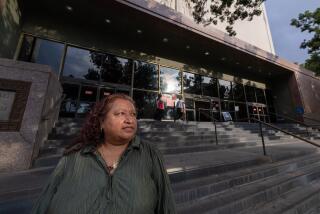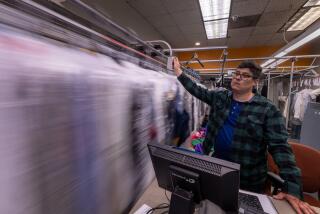Great Read: Legal clinic polishes non-lawyers’ civil suits
Henry Kornman’s window looks like one at a ticket office, with a metal grille to speak through and an opening for papers to be passed. People jot down their names with a pencil affixed to a plastic spoon and patiently wait to be summoned.
Clutching stacks of papers curled at the corners, they have come here to this window at the end of a fluorescent-lighted hallway in the federal courthouse — the soon-to-be foreclosed, the small-time copyright infringers, the mom-and-pop shop operators.
In a courthouse where six-figure cases are made, gang bosses are tried and senators are indicted, the cases that bring people to this free legal clinic for people representing themselves have decidedly more modest stakes. Yet they are fighting for a home, a Social Security check, a small business that’s everything they’ve worked for.
To spend a day at the courthouse clinic is to get a glimpse of the daunting U.S. justice system through the eyes of an everyman: the do-it-yourself lawyer.
At 9:30 a.m., the clinic opens for business, and Kornman, its bespectacled paralegal-slash-gatekeeper, greets those waiting at his window.
“First time to our clinic? Welcome,” he says warmly. “Get comfortable, and I’ll call you in a second.”
::
The number of non-incarcerated people representing themselves pro se, Latin “for himself,” has more than doubled since the economic downturn in the Central District of California. Many can’t afford lawyers, and most of their grievances don’t come with price tags that attract attorneys in the first place.
So they choose to go it alone, for better or worse. Some get a hand from the free Federal Pro Se Clinic, in downtown Los Angeles. Operated by the nonprofit Public Counsel and funded by a private law firm and fees paid by new lawyers, it is one of the first of its kind in the nation and one of the largest.
Unlike in criminal cases, indigent people suing or being sued in civil lawsuits aren’t provided lawyers. But no one tells the Average Joe litigant who shows up at the courthouse of the hoops he’ll have to jump through before he’ll get the chance to tell his side of the story before an arbiter, if that day ever comes.
In one 1997 analysis of 227 Northern California cases involving pro se parties, more than half were thrown out by a judge at an initial stage for various technical reasons. Only one case went to trial.
“They don’t get the Judge Judy, what they think of as the judicial process,” says Janet Lewis, a public interest lawyer who’s headed the clinic since it opened in 2009. “You can get through your entire case without walking into a courtroom and explaining your case in front of people, face to face.”
::
First in line on this Wednesday is Mohammed Ahsan, of Ahsan vs. the United States of America.
He has come with a large black umbrella and a well-worn, overstuffed briefcase. Most of the federal court system’s files may be digitized, but the clinic’s clientele skews decidedly analog — they come with hand- or typewritten legal motions, and more often than not, like Ahsan, they don’t have e-mail accounts.
Ahsan has lost count of the number of trips he had made from his home in Hawthorne to downtown Los Angeles, looking for someone who would listen to just how unfair it was that the IRS had put a lien on his humble home of twice its value.
It’s an uphill battle for a laid-off immigrant machinist trying to sue the U.S. government. The debt comes from a year he dabbled in stocks. He says he made some, lost some and came out in the red. But his broker, by his account, sent only the forms showing his earnings, and not his losses, to the IRS, which in turn slapped him with more than $600,000 in taxes.
Now, at 79 — possibly older, because his age was approximated by a teacher in his native India — and divorced, he is facing the loss of his last possession, his home.
“There’s still time to figure this out,” Andy Ferguson, a bright-eyed patent lawyer and a regular volunteer at the clinic, tells Ahsan. He explains that the notice Ahsan got from the court says he hadn’t properly served the defendant with his lawsuit — one of the most common mistakes made by the self-represented. Ferguson scans Ahsan’s typewritten complaint and is optimistic. It’s well written for a pro se complaint, he thinks, and it just might have a shot.
A few windows down, Kornman is entertaining a different sort of complaint against the government from a clean-cut man, patiently jotting down notes.
“And the NSA surveilled you?”
::
Late morning is peak time for the clinic, and the cases stream in.
Connie Salcedo was pulled into the justice system when someone knocked on her door shortly before Christmas and served her with a lawsuit. The restaurant space she and her husband had rented out on Cesar Chavez Avenue was being sued for an Americans With Disabilities Act violation — a latch on the back screen door had broken, and the lessee operating the burrito and taco joint had propped it open with a cinder block for a few days.
A man in a wheelchair sued for not having been able to access the business because of the block. The same man had sued 17 other businesses in less than a year.
Now, Salcedo, 65, is getting a crash course in terms such as discovery, indemnification and summary judgment, and faces a potential penalty of $4,000. Lewis walks her through the process of requesting evidence from the other side to structure her argument in a motion to dismiss the case, proving she was not involved in the day-to-day operation of the restaurant but simply leased out the space.
“Whatever happens happens, I just want to speak my piece,” she says. “They’re helping me a great deal, thank God.”
::
Fire Wilson walks in shortly before lunch. The night before, she had sent the clinic’s resident social worker 10 angry e-mails. She had lost her case against a trust employee whom she accused of mishandling her late mother’s estate in Florida and seemed to be looking for someone to blame.
The clinic’s staff attorney, Frances Azizi, meets with her. A onetime tax litigator, Azizi has come to learn that the job can often be, as she puts it, “Oprah-esque.” She recalled an Army civil engineer who received a $180,000 settlement in an employment discrimination suit but wanted to keep fighting for a simple apology or some type of mea culpa.
“People just want us to say, ‘Sorry this happened to you,’” she says.
Azizi asks Wilson what she wants to do now that the judge had ruled against her. She points out that even if Wilson isn’t happy with the outcome, the judge had thoroughly considered the case and explained her reasoning in her decision.
“Whatever I can … I want to cost them as much money as I can,” Wilson responds, holding a stack of legal papers with notes scribbled throughout.
“Thinking practically, is it worth your time?” Azizi asks. “I want you to be emotionally prepared for it not to work at the appellate level. Anger isn’t healthy.”
::
The afternoon brings Carl Jackson, a tall, mustachioed gentleman in a leather jacket who has six questions about his Fair Debt Collection Practices Act lawsuit, alleging that a debt collector had improperly harassed him, meticulously written up in a legal pad.
First on his list — the official court record was missing page 9 of his complaint, and he wasn’t sure how to fix the simple problem.
“I sure appreciate you guys being here, because I don’t know what I would be doing otherwise,” he says, going down his list of questions.
In all, 15 people bring their stories to the clinic on this day, five of them first-timers. Not all of them will be successful — Ahsan’s lawsuit and Wilson’s motion for reconsideration will later be dismissed, and Salcedo will be able to reach a settlement out of court — but they will have gotten at least one willing ear to hear their tale.
“When they get somebody who’s actually willing to listen to them, they pour it out,” says Ferguson, the volunteer. “They’re so lonely in the process.”
More to Read
Sign up for Essential California
The most important California stories and recommendations in your inbox every morning.
You may occasionally receive promotional content from the Los Angeles Times.











